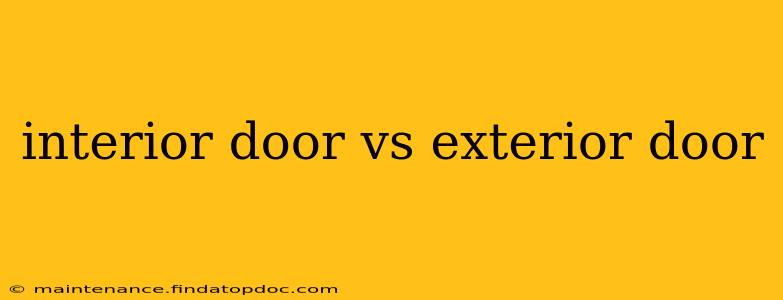Choosing the right door for your home can significantly impact its energy efficiency, security, and overall aesthetic appeal. Understanding the key differences between interior and exterior doors is crucial for making informed decisions. This comprehensive guide will delve into the specifics, helping you determine which type of door best suits your needs.
What Makes an Exterior Door Different from an Interior Door?
The most significant differences between interior and exterior doors lie in their construction, materials, and features. Exterior doors are designed to withstand harsh weather conditions, provide superior security, and offer better energy efficiency. Interior doors, on the other hand, prioritize aesthetics, sound dampening, and ease of installation.
Construction and Materials:
-
Exterior Doors: These doors are typically constructed from solid core wood, fiberglass, or steel, offering greater durability and resistance to impact. They are often weather-stripped and feature multiple layers to improve insulation and prevent drafts. The exterior finish is designed to withstand sun exposure, rain, and temperature fluctuations.
-
Interior Doors: Interior doors commonly use hollow-core or solid-core construction. Hollow-core doors are lightweight and budget-friendly, while solid-core doors offer improved sound insulation and privacy. Materials range from wood and composite materials to engineered wood. They do not require the same level of weather protection as exterior doors.
Weather Resistance:
-
Exterior Doors: This is a critical factor. Exterior doors need to resist moisture, wind, and extreme temperatures. They are typically treated with weather-resistant coatings and sealants to prevent damage and maintain their functionality. Proper weatherstripping around the door frame is also essential.
-
Interior Doors: Weather resistance is not a primary concern for interior doors. While moisture damage can still occur, it's significantly less of a concern compared to exterior doors.
Security Features:
-
Exterior Doors: Security is paramount for exterior doors. They often feature reinforced frames, multi-point locking systems, and high-quality deadbolt locks for enhanced protection against intruders. Some even come with additional security features like viewing windows and security chains.
-
Interior Doors: Security is less of a primary concern, though some interior doors might offer basic locking mechanisms for privacy.
Energy Efficiency:
-
Exterior Doors: Energy efficiency is a key consideration for exterior doors. Features like insulated cores, weatherstripping, and tight seals help minimize energy loss through drafts and heat transfer. The R-value (resistance to heat flow) is a crucial indicator of energy efficiency.
-
Interior Doors: Energy efficiency is less crucial for interior doors, although solid-core doors offer better sound insulation, which can indirectly contribute to energy savings.
What are the Different Types of Interior Doors?
Interior doors come in a variety of styles, materials, and finishes to suit different aesthetic preferences and functional requirements. Common types include:
-
Solid Core Doors: These offer better soundproofing and durability compared to hollow-core doors.
-
Hollow Core Doors: These are more affordable and lightweight, suitable for areas where sound insulation is less critical.
-
French Doors: These double doors offer both style and functionality, ideal for creating a connection between rooms.
-
Pocket Doors: These slide into a wall cavity, saving space in smaller rooms.
-
Barn Doors: These add a rustic charm and can be used in a variety of settings.
What are the Different Types of Exterior Doors?
Exterior doors are available in a wide array of styles, materials, and configurations to complement various architectural styles and security needs. Popular types include:
-
Fiberglass Doors: These are highly durable and require minimal maintenance, offering excellent energy efficiency.
-
Steel Doors: These are strong and secure, providing excellent protection against intruders.
-
Wood Doors: These offer classic beauty and can be customized with various finishes. They require more maintenance than fiberglass or steel doors.
How Much Do Interior and Exterior Doors Cost?
The cost of interior and exterior doors varies widely depending on the material, size, style, and features. Interior doors can range from a few hundred dollars to several thousand, while exterior doors can cost even more, sometimes exceeding several thousand dollars depending on the type and features.
What are the Common Problems with Interior and Exterior Doors?
Common problems associated with interior doors include sticking, warping due to moisture, and damage to the finish. Exterior doors can suffer from similar issues, plus problems with seals and weatherstripping, leading to drafts and energy loss. Security concerns are also more prominent with exterior doors.
How to Choose the Right Door for Your Home?
Choosing the right door involves considering several factors, including budget, style, security requirements, energy efficiency goals, and the overall aesthetic of your home. Weighing these factors carefully will help you select the perfect interior and exterior doors that meet your specific needs.
This detailed analysis provides a comprehensive understanding of the differences between interior and exterior doors, equipping you with the knowledge to make an informed choice for your home. Remember to consider the specific needs of each doorway when making your selections.
